

Sultanahmet
Go Back to Istanbul Subway Main Page


The Hippodrome today, with the Walled Obelisk in the foreground and
Thutmosis' Obelisk on the right
|

Location of the Hippodrome in Constantinople
|

Procession of the guilds in front of the Sultan in the Hippodrome,
Ottoman miniature from the Surname-i Vehbi (1582)
|

Obelisk of Thutmosis III
|

The base of the Obelisk of Thutmosis III showing Emperor Theodosius as
he offers a laurel wreath to the victor from the Kathisma at the
Hippodrome
|

The Serpent Column |

The Walled Obelisk |
The Hippodrome of Constantinople (Turkish: Sultanahmet Meydanı, At Meydanı) was a horse-racing track that was the sporting and social centre of Constantinople, capital of the Byzantine Empire and the largest city in Europe. Today it is a square named Sultanahmet Meydanı (Sultan Ahmet Square) in the Turkish city of Istanbul, with only a few fragments of the original structure surviving. It is sometimes also called Atmeydanı (Horse Square) in Turkish.
The word hippodrome comes from the Greek hippos ('ιππος), horse, and dromos (δρομος), path or way. Horse racing and chariot racing were popular pastimes in the ancient world and hippodromes were common features of Greek cities in the Hellenistic, Roman and Byzantine eras.
Although the Hippodrome is usually associated with Constantinople's days of glory as an imperial capital, it actually predates that era. The first Hippodrome was built when the city was called Byzantium (Βυζαντιον, or Byzantion in Greek), and was a provincial town of moderate importance. In 203 the Emperor Septimius Severus rebuilt the city and expanded its walls, endowing it with a hippodrome, an arena for chariot races and other entertainment.
In 324, the Emperor Constantine the Great decided to move the seat of the government from Rome to Byzantium, which he renamed Nova Roma (New Rome). This name failed to impress and the city soon became known as Constantinople, the City of Constantine. Constantine greatly enlarged the city, and one of his major undertakings was the renovation of the Hippodrome. It is estimated that the Hippodrome of Constantine was about 450 metres long and 130 metres wide. Its stands were capable of holding 100,000 spectators.
The race-track at the Hippodrome was U-shaped, and the Kathisma (emperor's loge) was located at the eastern end of the track. The Kathisma could be accessed directly from the Great Palace through a passage which only the emperor or other members of the imperial family could use. The Hippodrome Boxes, which had four statues of horses in gilded copper on top, stood at the northern end; and the Sphendone (curved tribune of the U-shaped structure, the lower part of which still survives) stood at the southern end. These four gilded horses, now called the Horses of Saint Mark, whose exact Greek or Roman ancestry has never been determined, were looted during the Fourth Crusade in 1204 and installed on the façade of St Mark's Basilica in Venice. The track was lined with other bronze statues of famous horses and chariot drivers, none of which survive. The hippodrome was filled with statues of gods, emperors and heroes, among them some famous works, such as a Heracles by Lysippos, Romulus and Remus with their wolf and the Serpent Column of the Plataean tripod In his book De Ceremoniis (book II,15, 589), the emperor Constantine Porphyrogenitus described the decorations in the hippodrome at the occasion of the visit of Saracen or Arab visitors, mentioning the purple hangings and rare tapestries.
Throughout the Byzantine period, the Hippodrome was the centre of the city's social life. Huge amounts were bet on chariot races, and initially four teams took part in these races, each one financially sponsored and supported by a different political party (Deme) within the Roman/Byzantine Senate: The Blues (Venetii), the Greens (Prasinoi), the Reds (Rousioi) and the Whites (Leukoi). The Reds (Rousioi) and the Whites (Leukoi) gradually weakened and were absorbed by the other two major factions (the Blues and Greens).
A total of up to eight chariots (two chariots per team), powered by four horses each, competed on the racing track of the Hippodrome. These races were not simple sporting events, but also provided some of the rare occasions in which the Emperor and the common citizens could come together in a single venue. Political discussions were often made at the Hippodrome, which could be directly accessed by the Emperor through a passage that connected the Kathisma (Emperor's Loge at the eastern tribune) with the Great Palace of Constantinople.
The rivalry between the Blues and Greens often became mingled with political or religious rivalries, and sometimes riots, which amounted to civil wars that broke out in the city between them. The most severe of these was the Nika Revolt of 532, in which an estimated 30,000 people were killed and many important buildings, such as the second Hagia Sophia Church, were destroyed. The current (third) Hagia Sophia was built by Justinian following the Nika Revolt.
Constantinople never really recovered from its sack during the Fourth Crusade and even though the Byzantine Empire survived until 1453, by that time, the Hippodrome had fallen into ruin. The Ottoman Turks, who captured the city in 1453 and made it the capital of the Ottoman Empire, were not interested in racing and the Hippodrome was gradually forgotten, although the site was never actually built over.
The Hippodrome was used for various occasions such as the lavish and days-long circumcision ceremony of the sons of Sultan Ahmed III. In Ottoman miniature paintings, the Hippodrome is shown with the seats and monuments still intact. Although the structures do not exist anymore, today's Sultanahmet Square largely follows the ground plan and dimensions of the now vanished Hippodrome.
To raise the image of his new capital, Constantine and his successors, especially Theodosius the Great, brought works of art from all over the empire to adorn it. The monuments were set up in the middle of the Hippodrome, the spina. Among these was the Tripod of Plataea, now known as the Serpent Column, cast to celebrate the victory of the Greeks over the Persians during the Persian Wars in the 5th century BC. Constantine ordered the Tripod to be moved from the Temple of Apollo at Delphi, and set in middle of the Hippodrome. The top was adorned with a golden bowl supported by three serpent heads. The bowl was destroyed or stolen during the Fourth Crusade. The serpent heads were destroyed as late as the end of the 17th Century, as many Ottoman miniatures show they were intact in the early centuries following the Turkish conquest of the city. Parts of the heads were recovered and are displayed at the Istanbul Archaeology Museum. All that remains of the Delphi Tripod today is the base, known as the "Serpentine Column".
Another emperor to adorn the Hippodrome was Theodosius the Great, who in 390 brought an obelisk from Egypt and erected it inside the racing track. Carved from pink granite, it was originally erected at the Temple of Karnak in Luxor during the reign of Tuthmosis III in about 1490 BC. Theodosius had the obelisk cut into three pieces and brought to Constantinople. Only the top section survives, and it stands today where Theodosius placed it, on a marble pedestal. The obelisk has survived nearly 3,500 years in astonishingly good condition.
In the 10th century the Emperor Constantine Porphyrogenitus built another obelisk at the other end of the Hippodrome. It was originally covered with gilded bronze plaques, but they were sacked by Latin troops in the Fourth Crusade. The stone core of this monument also survives, known as the Walled Obelisk.
Seven statues were erected on the Spina of the Hippodrome in honour of Porphyrios, a legendary charioteer in his time who raced for the two parties which were called "Greens" and "Blues". None of these statues have survived. Only the bases of two of them have survived and are displayed in the Istanbul Archaeological Museum.
Today the area is officially called Sultan Ahmet Square, and is carefully maintained by the Turkish authorities. The course of the old racetrack has been indicated with paving, although the actual track is some two metres below the present surface. The surviving monuments of the Spina (the middle barrier of the racecourse), the two obelisks and the Serpentine Column, now sit in holes in a landscaped garden.
The German Fountain ("The Kaiser Wilhelm Fountain"), an octagonal domed fountain in neo-byzantine style, which was constructed by the German government in 1900 to mark the German Emperor Wilhelm II's visit to Istanbul in 1898, is located at the northern entrance to the Hippodrome area, right in front of the Blue Mosque.
The Hippodrome has never been systematically excavated by archaeologists. A portion of the substructures of the Sphendone (the curved end) became more visible in the 1980s with the clearing of houses in the area.
In 1993 an area in front of the nearby Sultanahmet Mosque (the Blue Mosque) was bulldozed in order to install a public toilet, uncovering several rows of seats and some columns from the Hippodrome. Investigation did not continue further, but the seats and columns were removed and can now be seen in Istanbul's museums. It is possible that much more of the Hippodrome's remains still lie beneath the parkland of Sultanahmet.

Base of the statues of Porphyrios, kept in the Istanbul Museum
|

The four bronze horses that used to be in the Hippodrome, today in
Venice
|

The remains of the Sphendone
|

The neo-byzantine German Fountain
|
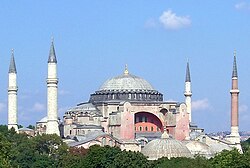
Exterior view of the Hagia Sophia, 2004
|

Interior view of the Hagia Sophia from the upper gallery
|
Hagia Sophia (Turkish: Ayasofya, Greek: Αγία Σοφία; "Holy Wisdom", Latin: Sancta Sophia or Sancta Sapientia) is a former patriarchal basilica, later a mosque, now a museum in Istanbul, Turkey. Famous in particular for its massive dome, it is considered the epitome of Byzantine architecture. It was the largest cathedral ever built in the world for nearly a thousand years, until the completion of the Seville Cathedral in 1520. The current building was originally constructed as a church between A.D. 532 and 537 on the orders of the Byzantine Emperor Justinian, and was in fact the third Church of the Holy Wisdom to occupy the site (the previous two had both been destroyed by riots). It was designed by two architects, Isidore of Miletus and Anthemius of Tralles. The Church contained a large collection of holy relics and featured, among other things, a 50 foot (15 m) silver iconostasis. It was the patriarchal church of the Patriarch of Constantinople and the religious focal point of the Eastern Orthodox Church for nearly 1000 years.
In 1453, Constantinople was conquered by the Ottoman Turks and Sultan Mehmed II ordered the building to be converted into the Ayasofya Mosque. The bells, altar, iconostasis, and sacrificial vessels were removed, and many of the mosaics were eventually plastered over. The Islamic features such as the mihrab, the minbar, and the four minarets outside were added over the course of its history under the Ottomans. It remained as a mosque until 1935, when it was converted into a museum by the Republic of Turkey.
For almost 500 years the principal mosque of Istanbul, Hagia Sophia served as a model for many of the Ottoman mosques such as the Sultan Ahmed Mosque (Blue Mosque of Istanbul), the Şehzade Mosque, the Süleymaniye Mosque, and the Rüstem Pasha Mosque.
Although it is sometimes referred to as Saint Sophia (Greek for wisdom), the Greek name in full is Ναός τῆς Ἁγίας τοῦ Θεοῦ Σοφίας, Church of the Holy Wisdom of God, and it was dedicated to the Holy Wisdom of God rather than a specific saint named Sophia.

Nothing remains of the first church that was built on this location, known as the Μεγάλη Ἐκκλησία (Megálē Ekklēsíā, "Great Church"), or in Latin "Magna Ecclesia".
As often happened in those days, the site was selected because there had been a pagan temple there. The church was built next to the area where the imperial palace was being developed and next to the smaller church Hagia Eirene, finished first and acting as cathedral until the Hagia Sophia was completed. The Hagia Sophia was inaugurated by Constantius II on 15 February 360. Both churches acted together as the principal churches of the Byzantine Empire.
This church was chronicled by Socrates of Constantinople (380440), who claimed that it was built by Constantine the Great. It was built as a traditional Latin colonnaded basilica with galleries and a wooden roof. It was preceded by an atrium. This first church was then already claimed to be one of the world's most outstanding monuments.
The appellation "Megálē Ekklēsíā" continued to be used for a long time, only to be replaced by the name "Hagia Sophia" after the conquest of Byzantium in 1453
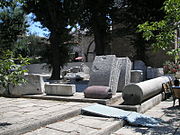
The patriarch of Constantinople, John Chrysostom, came into a conflict with Empress Aelia Eudoxia, wife of the Emperor Arcadius and was sent into exile on 20 June 404. During the subsequent riots, this first church was largely burned down. A second church was ordered by Theodosius II, who inaugurated it on 10 October 405. The basilica with a wooden roof was built by architect Rufinos.
The fire that started during the tumult of the Nika Revolt resulted in the destruction of the (second) Hagia Sophia, which burned down to the ground on 1314 January 532.
Several marble blocks from this second church have survived to the present day, and they are displayed in the garden of the current (third) church. The blocks were originally part of a monumental front entrance; they were excavated in the western courtyard by A.M. Schneider in 1935. The relief depicting 12 lambs 12 apostles as well as other remains of this church were discovered during excavation works in 1935. In order not to harm the present Hagia Sophia building, further excavation works were not carried out.

On February 23, 532, only a few days after the destruction of the second basilica, Emperor Justinian I took the decision to build a third and entirely different basilica, larger and more majestic than its predecessors.
Justinian chose the physicist Isidore of Miletus and the mathematician Anthemius of Tralles as architects; Anthemius, however, died within the first year. The construction is described by the Byzantine historian Procopius' On Buildings (Peri ktismatōn, Latin: De aedificiis). The emperor had material brought over from all over the empire, such as Hellenistic columns from the temple of Artemis at Ephesus. Large stones were brought from far-away quarries: porphyry from Egypt, green marble from Thessaly, black stone from the Bosporus region and yellow stone from Syria. More than ten thousand people were employed during this construction. This new church was immediately recognized as a major work of architecture, demonstrating the creative insights of the architects. They may have used the theories of Heron of Alexandria to be able to construct a huge dome over such a large open space. The emperor, together with the patriarch Eutychius, inaugurated the new basilica on December 27, 537 with much pomp and circumstance. The mosaics inside the church were, however, only completed under the reign of Emperor Justin II (565578).
Earthquakes in August 553 and on December 14, 557 caused cracks in the main dome and the eastern half-dome to appear. The main dome collapsed completely during an earthquake on May 7, 558, destroying the ambon, the altar and the ciborium over it. The emperor ordered an immediate restoration. He entrusted it to Isodorus the Younger, nephew of Isidore of Miletus. This time he used lighter materials and elevated the dome by 6.25 metres (20.5 ft), thus giving the building its current interior height of 55.6 metres (182 ft). This reconstruction, giving the church its present 6th century form, was completed in 562. The Byzantine poet Paul the Silentiary composed an extant, long epic poem, known as Ekphrasis, for the rededication of the basilica, presided over by Patriarch Eutychius, on 23 December 562.
Hagia Sophia was the seat of the Orthodox patriarch of Constantinople and a principal setting for Byzantine imperial ceremonies, such as coronations. The basilica also offered asylum to wrongdoers. Foreign visitors were deeply impressed.
In 726 the Emperor Leo the Isaurian issued a series of edicts against the veneration of images, ordering the army to destroy all icons (iconoclasm). At that time, all religious pictures and statues were removed from the Hagia Sophia. After a brief reprieve under Empress Irene (797802), the iconoclasts made a comeback. Emperor Theophilus (829842) was strongly influenced by Islamic art, which forbids graven images. He had a two-winged bronze door with his monograms installed at the southern entrance of the church.
The basilica suffered damage, first by a great fire in 859, and again by an earthquake on January 8, 869 that made a half-dome collapse. Emperor Basil I ordered the church to be repaired.
After the great earthquake of 25 October 989, which ruined the great dome of Hagia Sophia, the Byzantine emperor Basil II asked for the Armenian architect Trdat, creator of the great churches of Ani and Agine, to repair the dome. His main repairs were to the western arch and a portion of the dome. The extent of the church's destruction meant that reconstruction lasted six years. The church was re-opened on 13 May 994.
In his book De caerimoniis aulae Byzantinae (Book of Ceremonies), emperor Constantine VII (913919) wrote about all the details of the ceremonies held in the Hagia Sophia by the emperor and the patriarch.
At the capture of Constantinople during the Fourth Crusade, the church was ransacked and desecrated by the Latin Christians. The Byzantine historian Niketas Choniates described the capture of Constantinople. Many relics from the church, such as a stone from the tomb of Jesus, the Virgin Mary's milk, the shroud of Jesus, and bones of several saints, were sent to churches in the West and can be seen now in various museums in the West. During the Latin occupation of Constantinople (12041261) the church became a Roman Catholic cathedral. Baldwin I of Constantinople was crowned emperor on 16 May 1204 in the Hagia Sophia, at a ceremony which closely followed Byzantine practices. Enrico Dandolo, the Doge of Venice who commanded the sack and invasion of the city by the Latin Crusaders in 1204, is buried inside the church. The tomb inscription carrying his name, which has become a part of the floor decoration, was spat upon by many of the angry Byzantines who recaptured Constantinople in 1261. However, restoration carried out during the period 18471849 cast doubt upon the authenticity of the doge's grave. It is more likely a symbolic burial site to keep alive his memory.
After the recapture in 1261 by the Byzantines, the church was in a dilapidated state. The four buttresses in the west were probably built during this time. In 1317, emperor Andronicus II ordered four new buttresses to be built in the eastern and northern parts of the church. After new cracks had developed in the dome after the earthquake of October 1344, several parts of the building collapsed on 19 May 1346. After that, the church remained closed until 1354, when repairs were undertaken by the architects Astras and Peralta.


Immediately after the Ottoman Turks conquered Constantinople (Istanbul) in 1453, the Hagia Sophia was converted to the Ayasofya Mosque as the symbol of the conquest. At that time, the church was very dilapidated. Several of its doors had fallen off. This condition was described by several Western visitors, such as the Córdoban nobleman Pero Tafur and the Florentine Cristoforo Buondelmonti. The sultan Mehmed II ordered the immediate cleanup of the church and its conversion to a mosque. The next sultan Bayezid II built a new minaret, replacing the one built by his father.
In the 16th century the sultan Suleiman the Magnificent (15201566) brought back two colossal candles from his conquest of Hungary. They were placed on both sides of the mihrab. During the reign of Selim II (15661577), the building started showing signs of fatigue and was extensively strengthened with the addition of structural supports to its exterior by the great Ottoman architect Sinan, who is also considered one of the world's first earthquake engineers. In addition to strengthening the historic Byzantine structure, Sinan built the two additional large minarets at the western end of the building, the original sultan's loge, and the mausoleum of Selim II to the southeast of the building (then a mosque) in 1577. The mausoleums of Murad III and Mehmed III were built next to it in the 1600s.
Later additions were the sultan's gallery, a minbar decorated with marble, a dais for a sermon and a loggia for a muezzin.
The sultan Murad III (15741595) had two large alabaster Hellenistic urns transported from Pergamon and placed on two sides of the nave.
Sultan Mahmud I ordered the restoration of the building in 1739 and added a medrese (a Koranic school, now the library of the museum), a soup kitchen (for distribution to the poor) and a library, and in 1740 a fountain for ritual ablutions (Şadirvan), thus transforming it into a külliye, i.e. a social complex. At the same time a new sultan's gallery and a new mihrab were built inside.
The most famous restoration of the Hagia Sophia was ordered by Sultan Abdülmecid and completed by eight hundred workers between 1847 and 1849, under the supervision of the Swiss-Italian architect brothers Gaspare and Giuseppe Fossati. The brothers consolidated the dome and vaults, straightened the columns, and revised the decoration of the exterior and the interior of the building. The mosaics in the upper gallery were cleaned. The old chandeliers were replaced by new pendant ones. New gigantic circular-framed disks were hung on columns. They were inscribed with the names of Allah, the prophet Muhammad, the first four caliphs Abu Bakr, Umar, Uthman and Ali, and the two grandchildren of Mohammed: Hassan and Hussain, by the calligrapher Kazasker İzzed Effendi (18011877). In 1850 the architect Fossati built a new sultan's gallery in a Neo-Byzantine style connected to the royal pavilion behind the mosque. Outside the Hagia Sophia, a timekeeper's building and a new medrese were built. The minarets were altered so that they were of equal height. When the restoration was finished, the mosque was re-opened with ceremonial pomp on 13 July 1849.
In 1935, the first Turkish President and founder of the Republic of Turkey, Mustafa Kemal Atatürk, transformed the building into a museum. The carpets were removed and the marble floor decorations appeared for the first time in centuries, while the white plaster covering the mosaics was painstakingly removed by expert restorers.

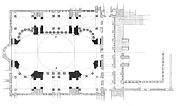
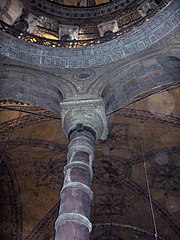
Hagia Sophia is one of the greatest surviving examples of Byzantine architecture. Of great artistic value was its decorated interior with mosaics and marble pillars and coverings. The temple itself was so richly and artistically decorated that Justinian proclaimed, "Solomon, I have surpassed thee!" (Νενίκηκά σε Σολομών). Justinian himself had overseen the completion of the greatest cathedral ever built up to that time, and it was to remain the largest cathedral for 1,000 years up until the completion of the cathedral in Seville in Spain.
Justinian's basilica was at once the culminating architectural achievement of late antiquity and the first masterpiece of Byzantine architecture. Its influence, both architecturally and liturgically, was widespread and enduring in the Eastern Orthodox, Roman Catholic, and Muslim worlds alike. The largest columns are about 19 or 20 meters tall. They are at least 1.5 meters diameter. They are made out of granite. the largest weigh well over 70 tons. For more on the columns see the talk section. Under Justinian's orders, eight Corinthian columns were disassembled from Baalbek, Lebanon and shipped to Constantinople for the construction of Hagia Sophia.
The vast interior has a complex structure. The vast nave is covered by a central dome which has a maximum diameter of 31.24 metres (102 ft 6 in) and a height from floor level of 55.6 metres (182 ft 5 in), about one fourth smaller than the dome of the Pantheon. The dome seems rendered weightless by the unbroken arcade of 40 arched windows under it, which help flood the colourful interior with light. Due to consecutive repairs in the course of its history, the dome has lost its perfect circular base and has become somewhat elliptical with a diameter varying between 31.24 m (102 ft 6 in) and 30.86 m (101 ft 3 in).
The dome is carried on pendentives four concave triangular sections of masonry which solve the problem of setting the circular base of a dome on a rectangular base. At Hagia Sophia the weight of the dome passes through the pendentives to four massive piers at the corners. Between them the dome seems to float upon four great arches. These were reinforced with buttresses during Ottoman times, under the guidance of the architect Sinan.
At the western (entrance) and eastern (liturgical) ends, the arched openings are extended by half domes carried on smaller semi-domed exedras. Thus a hierarchy of dome-headed elements builds up to create a vast oblong interior crowned by the main dome, a sequence unexampled in antiquity. Despite all these measures, the weight of the dome remained a problem, which was solved by adding buttresses from the outside.
All interior surfaces are sheathed with polychrome marbles, green and white with purple porphyry and gold mosaics, encrusted upon the brick. This sheathing camouflaged the large pillars, giving them, at the same time, a brighter aspect.
On the exterior, simple stuccoed walls reveal the clarity of massed vaults and domes. The yellow and red colour of the exterior was added by the architect Fossati during the restorations in the 19th century.
The dome of Hagia Sophia has spurred particular interest for many art historians, architects and engineers because of the innovative way the original architects envisioned the dome. The dome is supported by pendentives which had never been used before the building of this structure. The pendentive enables the dome to transition gracefully into the square shape of the piers below. The pendentives not only achieve a pleasing aesthetic quality, but they also restrain the lateral forces of the dome and allow the weight of the dome to flow downward.
Although this design stabilizes the dome and the surrounding walls and arches, the actual construction of the walls of Hagia Sophia weakened the overall structure. The bricklayers used more mortar than brick, which weakened the walls. The structure would have been more stable if the builders at least let the mortar cure before they began the next layer; however, they did not do this. When the dome was placed atop the building, the weight of the dome caused the walls to lean outward because of the wet mortar underneath. When Isidorus the Younger rebuilt the original dome, he had to first build up the interior of the walls so that they were vertical in order to support the weight of the new dome. Another probable change in the design of the dome when it was rebuilt was the actual height of the dome. Isidore the Younger raised the height of the dome by approximately twenty feet so that the lateral forces would not be as strong and the weight of the dome would flow more easily down the walls.
A second interesting fact about the original structure of the dome was how the architects were able to place forty windows around the base of the dome. Hagia Sophia is famous for the mystical quality of light that reflects everywhere in the interior of the nave, which gives the dome the appearance of hovering above the nave. This design is possible because the dome is shaped like a scalloped shell or the inside of an umbrella with ribs that extend from the top of the dome down to the base. These ribs allow the weight of the dome to flow between the windows, down the pendentives, and ultimately to the foundation.
The unique character of the design of Hagia Sophia show how this structure is one of the most advanced and ambitious monuments of late antiquity.
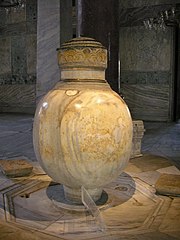
The marble jar was brought from Pergamon during the reign of Sultan Murad III. Originally from the Hellenistic period, it was carved from a single block of marble.
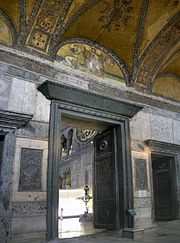
The Imperial Gate was the main entrance between the exo- and esonarthex. It was reserved only for the emperor. The Byzantine mosaic above the portal depicts Christ and Emperor Leo VI the Wise.
A long ramp from the northern part of the outer narthex leads up to the upper gallery.
The upper gallery is laid out in a horseshoe shape that encloses the nave until the apse. Several mosaics are preserved in the upper gallery, an area traditionally reserved for the empress and her court. The best-preserved mosaics are located in the southern part of the gallery.

The Loge of the Empress is located in the centre of the upper enclosure, or gallery, of the Hagia Sophia. From there the empress and the court-ladies would watch the proceedings down below. A round, green stone marks the spot where the throne of the empress stood.

The Marble Door inside the Hagia Sophia is located in the southern upper enclosure, or gallery. It was used by the participants in synods, they entered and left the meeting chamber through this door
Originally, under Justinian's reign, the interior decorations consisted of abstract designs of the marble slabs on the walls and mosaics on the curving vaults. Of these, one can still see the two archangels Gabriel and Michael in the spandrels of the bema. There were already a few figurative decorations, as attested by the eulogy of Paul the Silentiary. The spandrels of the gallery are revetted in opus sectile, showing patterns and figures of flowers and birds in precisely cut pieces of white marble set against a background of black marble. In later stages figurative mosaics were added, which were destroyed during the iconoclastic controversy (726843). Present mosaics are from the post-iconoclastic period. The number of treasures, relics and miracle-working, painted icons of the Hagia Sophia grew progressively richer into an amazing collection. Apart from the mosaics, a large number of figurative decorations were added during the second half of the ninth century: an image of Christ in the central dome; Orthodox saints, prophets and Church Fathers in the tympana below; historical figures connected with this church, such as Patriarch Ignatius; some scenes from the gospel in the galleries.

The church was richly decorated with mosaics throughout the centuries. They either depicted the Virgin Mother, Jesus, Saints, or emperors and empresses. Other parts were decorated in a purely decorative style with geometric patterns.
During the Sack of Constantinople in 1204, the Latin Crusaders vandalized the valuable items in every important Byzantine structure of the city, including the golden mosaics of the Hagia Sophia. Much of these valuable items were shipped to Venice, whose Doge, Enrico Dandolo, had organized the invasion and sack of Constantinople.
Following the building's conversion into a mosque in 1453, many of its mosaics were destroyed or covered with plaster, due to Islam's ban on representational imagery. This process was not completed at once, and reports exist from the 17th century in which travellers note that they could still see Christian images in the former church. In 184749, the building was restored by two Swiss brothers, Gaspare and Giuseppe Fossati, and Sultan Abdülmecid allowed them to also document any mosaics they might discover during this process. This work did not include repairing the mosaics and after recording the details about an image, the Fossatis painted it over again. This work included covering the previously uncovered faces of two seraphim mosaics located in the centre of the building. The building currently features a total of four of these images and two of them are restorations in paint created by the Fossatis to replace two images of which they could find no surviving remains. In other cases, the Fossatis recreated damaged decorative mosaic patterns in paint, sometimes redesigning them in the process. The Fossati records are the primary sources about a number of mosaic images now believed to have been completely or partially destroyed in an earthquake in 1894. These include a great mosaic of Christ Pantocrator in the dome, a mosaic over a now unidentified Door of the Poor, a large image of a jewel-encrusted cross and a large number of images of angels, saints, patriarchs, and church fathers. Most of the missing images were located in the building's two tympana. The Fossatis also added a pulpit (minbar) and the four large medallions on the walls of the nave bearing the names of Muhammad and Islam's first caliphs.



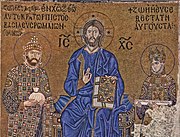

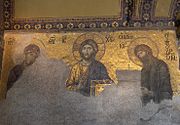


A large number of mosaics were uncovered in the 1930s by a team from the American Byzantine Institute led by Thomas Whittemore. The team chose to let a number of simple cross images remain covered by plaster, but uncovered all major mosaics found.
Due to its long history as both a church and a mosque, a particular challenge arises in the restoration process. The Christian iconographic mosaics are being gradually uncovered. However, in order to do so, important, historic Islamic art would have to be destroyed. Restorers have attempted to maintain a balance between both Christian and Islamic cultures. In particular, much controversy rests upon whether the Islamic calligraphy on the dome of the cathedral should be removed, in order to permit the underlying Pantocrator mosaic of Christ as Master of the World, to be exhibited (assuming the mosaic still exists)
One of the minarets (at southwest) was built from red brick while the other three were built from white marble; of which the slender one at northeast was erected by Sultan Bayezid II while the two larger minarets at west were erected by Sultan Selim II and designed by the famous Ottoman architect Sinan. The reason for the varying dimensions and mass of the minarets was to counterweight the main structure's mass and distribute the weight uniformly. This application by Mimar Sinan was one of the earliest seismic and geotechnical engineering efforts in the world. Latest research shows that without the counterweight of the minarets, the main structure would tend to collapse.
Exterior
|
Istanbul Pascal Sebah (1823-1886) - Vue de Constantinoples - 5
Mosquée de Sainte Sophie - 1880s.jpg
Early photograph showing the characteristic Ottoman stripes on the
facade that were later removed (1880)
|

View from Sultanahmet Square
|
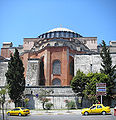
View of the apse with the butresses by Sinan
|

View at night
|
Interior
.JPG/90px-Hagia_Sophia_Constantinople_2007_(9).JPG)
View of the Theotokos mosaic in the apse
|

Byzantine pillars and arches
|

Capital with monogramm
|

Gate to the outer narthex with mosaics
|

View of the Imperial Gate and the Loge of the Empress
|

The "Beautiful Gate"
|

One of the runic inscriptions in Hagia Sophia, probably inscribed by
members of the Varangian Guard
|
Upper Gallery

Upper Gallery at the Loge of the Empress
|

Side gallery
|

Byzantine pillars with mosaics, and Ottoman-era paintings
|

Mosaic of Emperor Alexander holding a scroll and globus cruciger
|

Closeup of the marble door with key and keyhole
|

Prince Alexius at the Comnenus mosaic
|

Carved cross on one of the marble panels
|

Closeup of one of the Seraphim at the dome
|

View onto the Blue Mosque from one of the windows
|
Islamic elements

The Loge of the Sultan, decorated by the Fossati brothers
|

The mimbar from where the imam preached
|

Large medaillons by the Fossati brothers
The one on the left says "Uthman" (the third Rightly-Guided Caliph); the one on the right says "Hassan" (a grandson of Muhammad) |

Iznik tiles showing the Kaaba ( located next to the apse)
|

Illuminated Iraqi manuscript from the De Materia Medica (1224
AD), kept in the library
|

Ablution basins for cleaning before prayer, outside the main entrance
|
Historical drawings

Sketch of the mosaics in the eastern main arch and the apsis, by the
Fossati brothers when found in the 19th century
|

Sketch of the six patriarchs panel mosaics of the southern tympanon
(by Fossati)
|

Sketch of the six patriarchs panel mosaics of the northern tympanon
(by Fossati)
|


The Sultan Ahmed Mosque (Turkish: Sultanahmet Camii) is a historical mosque in Istanbul, the largest city in Turkey and the capital of the Ottoman Empire (from 1453 to 1923). The mosque is one of several mosques known as the Blue Mosque for the blue tiles adorning the walls of its interior. It was built between 1609 and 1616, during the rule of Ahmed I. Like many other mosques, it also comprises a tomb of the founder, a madrasah and a hospice. The Sultan Ahmed Mosque has become one of the greatest tourist attractions of Istanbul.
History


After the humiliating Peace of Zsitvatorok and the unfavourable result of the wars with Persia, Sultan Ahmed I decided to build a large mosque in Istanbul to placate Allah. This would be the first imperial mosque in more than forty years. Whereas his predecessors had paid for their mosques with their war booty, Sultan Ahmed I had to withdraw the funds from the treasury, because he had not won any notable victories. This provoked the anger of the ulema, the Muslim legal scholars.
The mosque was to be built on the site of the palace okf the Byzantine emperors, facing the Hagia Sophia (at that time the most venerated mosque in Istanbul) and the hippodrome, a site of great symbolic significance. Large parts of the southern side of the mosque rest on the foundations, the vaults and the undercrofts of the Great Palace. Several palaces, already built on the same spot, had to be bought (at considerable price) and pulled down, especially the palace of Sokollu Mehmet Paşa, and large parts of the Sphendone (curved tribune with U-shaped structure of the hippodrome).
Construction of the mosque started in August 1609 when the sultan himself came to break the first sod. It was his intention that this would become the first mosque of his empire. He appointed his royal architect Sedefhar Mehmet Ağa, a pupil and senior assistant of the famous architect Sinan as the architect in charge of the construction. The organization of the work was described in meticulous detail in eight volumes, now in the library of the Topkapı Palace. The opening ceremonies were held in 1617 (although the gate of the mosque records 1616) and the sultan was able to pray in the royal box (hünkâr mahfil). But the building wasn't finished yet in this last year of his reign, as the last accounts were signed by his successor Mustafa I. Known as the Blue Mosque, Sultan Ahmet Mosque is one of the most impressive monuments in the world. It is one of the elements included in the complex built by Ahmed I to compete with Ayasofya.
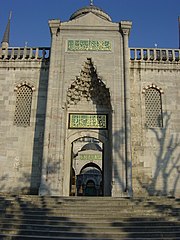
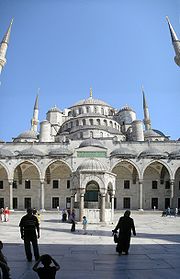
The design of the Sultan Ahmed Mosque is the culmination of two centuries of both Ottoman mosque and Byzantine church development. It incorporates some Byzantine elements of the neighboring Hagia Sophia with traditional Islamic architecture and is considered to be the last great mosque of the classical period. The architect has ably synthesized the ideas of his master Sinan, aiming for overwhelming size, majesty and splendour, but the interior lacks his creative thinking. During the rule of Ahmed I, Sultan Ahmet mosque was built between 1609 and 1616 CE. Designed by architect Sedefkar Mehmet Aga, the Sultan Ahmet Mosque is considered to be the last example of classical Ottoman architecture.
Mehmet Paşa used large quantities of materials for the construction, in particular stone and marble, draining away supplies for other important works. The layout of the mosque is irregular, as the architect had to take into account the existing constraints of the site. Its major façade, serving as the entrance, faces the hippodrome. The architect based his plan on the Sehzade Mosque (1543-1548) in Istanbul, the first major large-scale work of Sinan, with the same square-based symmetrical quatrefoil plan and a spacious forecourt. This prayer hall is topped by an ascending system of domes and semi-domes, each supported by three exedrae, culminating in the huge encompassing central dome, which is 23.5 meters in diameter and 43 meters high at its central point. The domes are supported by four massive piers that recall those of the Selimiye Mosque in Edirne, another masterpiece of Sinan. It is obvious that Mehmet Paşa was overcautious by taking this inflated margin of safety, damaging the elegant proportions of the dome by their oppressive size. These "elephant feet" consist of multiple convex marble grooves at their base, while the upper half is painted, separated from the base by an inscriptive band with gilded words. Seen from the court, the profile of the mosque becomes a smooth succession of domes and semi-domes. The overall effect of the exterior on the visitor is one of perfect visual harmony, leading the eye up to the peak of the central dome.
The façade of the spacious forecourt was built in the same manner as the façade of the Süleymaniye Mosque, except for the addition of the turrets on the corner domes. The court is about as large as the mosque itself and is surrounded by a continuous, rather monotonous, vaulted arcade (revak). It has ablution facilities on both sides. The central hexagonal fountain is rather small in contrast with the dimensions of the courtyard. The monumental but narrow gateway to the courtyard stands out architecturally from the arcade. Its semi-dome has a fine stalactite structure, crowned by a rather small ribbed dome on a tall drum.
A heavy iron chain hangs in the upper part of the court entrance on the western side. Only the sultan was allowed to enter the court of the mosque on horseback. The chain was put there, so that the sultan had to lower his head every time he entered the court in order not to get hit. This was done as a symbolic gesture, to ensure the humility (smallness) of the ruler in the face of the divine.

Interior view of the mosque; in the back, the mihrab; on the right side at the pier is the imperial loge

At its lower levels and at every pier, the interior of the mosque is lined with more than 20,000 handmade ceramic tiles, made at Iznik (the ancient Nicaea) in more than fifty different TULIP designs. The tiles at lower levels are traditional in design, while at gallery level their design becomes flamboyant with representations of flowers, fruit and cypresses. More than 20,000 tiles were made under the supervision of the Iznik master potter Kaşıcı Hasan,and Mustafa Mersin Efendi from Avanos(Cappadocia). However, the price the builders were able to pay for tiles was fixed by the sultan's decree, while tile prices increased over time. As a result, the tiles used later in building were of lesser quality. Their colours have faded and changed (red turning into brown and green into blue, mottled whites) and the glazes have dulled. The tiles on the back balcony wall are recycled tiles from the harem in the Topkapı Palace, when it was damaged by fire in 1574.
The upper levels of the interior are dominated by blue paint, but is of poor quality. More than 200 stained glass windows with intricate designs admit natural light, today assisted by chandeliers. On the chandeliers, ostrich eggs are found that were meant to avoid cobwebs inside the mosque by repelling spiders. The decorations include verses from the Qur'an, many of them made by Seyyid Kasim Gubari, regarded as the greatest calligrapher of his time. The floors are covered with carpets, which are donated by faithful people and are regularly replaced as they become worn out. The many spacious windows confer a spacious impression. The casements at floor level are decorated with opus sectile. Each exedra has five windows, some of which are blind. Each semi-dome has 14 windows and the central dome 28 (four of which are blind). The coloured glass for the windows was a gift of the Signoria of Venice to the sultan. Most of these coloured windows have by now been replaced by modern versions with little or no artistic merit.
The most important element in the interior of the mosque is the mihrab, which is made of finely carved and sculptured marble, with a stalactite niche and a double inscriptive panel above it. The adjacent walls are sheathed in ceramic tiles. But the many windows around it make it look less spectacular. To the right of the mihrab is the richly decorated minber, or pulpit, where the Imam stands when he is delivering his sermon at the time of noon prayer on Fridays or on holy days. The mosque has been designed so that even when it is at its most crowded, everyone in the mosque can see and hear the Imam.
The royal kiosk is situated at the south-east corner. It comprises a platform, a loggia and two small retiring rooms. It gives access to the royal loge in the south-east upper gallery of the mosque. These retiring rooms became the headquarters of the Grand Vizier during the suppression of the rebellious Janissary Corps in 1826. The royal loge (hünkâr mahfil) is supported by ten marble columns. It has its own mihrab, that used to be decorated with a jade rose and gilt and one hundred Qurans on inlaid and gilded lecterns.
The many lamps that light the interior was once covered with gold and gems. Among the glass bowls one could find ostrich eggs and crystal balls. All these decorations have been removed or pillaged for museums.
The great tablets on the walls are inscribed with the names of the caliphs and verses from the Quran, originally by the great 17th-century calligrapher Ametli Kasım Gubarım, but they have frequently been restored.

The Sultan Ahmed Mosque is one of the two mosques in Turkey that has six minarets, the other is in Adana. When the number of minarets was revealed, the Sultan was criticized for presumption, since this was, at the time, the same number as at the mosque of the Ka'aba in Mecca. He overcame this problem by paying for a seventh minaret at the Mecca mosque.
Four minarets stand at the corners of the mosque. Each of these fluted, pencil-shaped minarets has three balconies (ṣerefe) with stalactite corbels, while the two others at the end of the forecourt only have two balconies.
Until recently the muezzin or prayer-caller had to climb a narrow
spiral staircase five times a day to announce the call to prayer. Today a
public address system is used, and the call can be heard across the old part
of the city, echoed by other mosques in the vicinity. Large crowds of both
Turks and tourists gather at sunset in the park facing the mosque to hear the
call to evening prayers, as the sun sets and the mosque is brilliantly
illuminated by coloured floodlights.


As seen from the Hagia Sophia
|

Seen from Sultanahmed Square, close to the Hagia Sophia
|

Sunset over Bosphorus, left Blue Mosque, right Hagia Sophia
|

The mosque at night, well lit by floodlights
|

A cascading succession of semi-domes and a dome as seen from the inner
courtyard
|

Arcaded forecourt with one of the entrance gates
|

Interior of the mosque
|

Closer view of the main dome
|

Prayers inside
|
Go Back to Istanbul Subway Main Page
Hop On Hop Off City Sightseeing Istanbul - City Tour - Ho Ho Points
![]()
Home |
Ana
Sayfa | All About Turkey |
Turkiye
hakkindaki Hersey | Turkish Road Map
| Historical Places in Adiyaman |
Historical
Places in Turkey | Mt.Nemrut |
Slide
Shows | Related Links |
Guest
Book | Disclaimer | Send a Postcard | Travelers' Stories |
Donate a little to help |
Istanbul Subways |
Adiyaman Forum
|
|